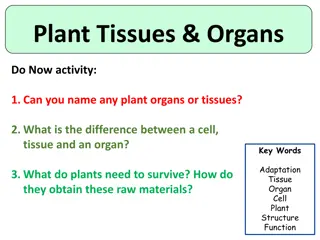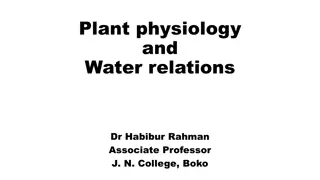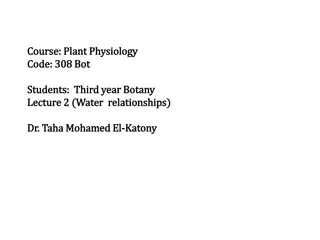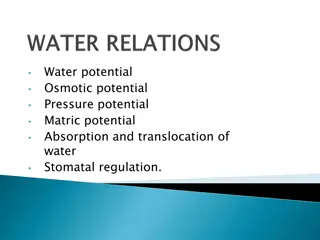Understanding Water Relationships in Plant Physiology
Water plays a crucial role in the physiology of plants, with most absorbed water being translocated to leaves and lost through transpiration and guttation. While essential for turgidity and mineral translocation, plant water use is often inefficient. Transpiration is the primary mode of water loss, supplemented by minor contributions from guttation, secretion, and bleeding. Factors favoring guttation include high water absorption, root pressure, and reduced transpiration. Guttation liquid is not pure water, containing various solutes.
Download Presentation

Please find below an Image/Link to download the presentation.
The content on the website is provided AS IS for your information and personal use only. It may not be sold, licensed, or shared on other websites without obtaining consent from the author. Download presentation by click this link. If you encounter any issues during the download, it is possible that the publisher has removed the file from their server.
E N D
Presentation Transcript
Course: Plant Physiology Course: Plant Physiology Code: Code: 308 308 Bot Bot Students: Third year Botany Students: Third year Botany Lecture Lecture 4 4 (Water relationships) (Water relationships) Dr. Dr. Taha Taha Mohamed El Mohamed El- -Katony Katony
Chapter III. Water loss: Chapter III. Water loss: Transpiration and Guttation Transpiration and Guttation Water is the major constituent of plant body, yet only a Water is the major constituent of plant body, yet only a small portion of the absorbed water is retained for small portion of the absorbed water is retained for metabolic processes. metabolic processes. Most of the absorbed water is Most of the absorbed water is translocated leaves and lost to the atmosphere due to the leaves and lost to the atmosphere due to the anatomical features of the leaves. anatomical features of the leaves. translocated to the to the Aside from the role of water in maintenance of Aside from the role of water in maintenance of turgidity and in translocation of dissolved minerals, turgidity and in translocation of dissolved minerals, water use in plants is inefficient. water use in plants is inefficient.
Water loss from plants occurs primarily through Water loss from plants occurs primarily through transpiration, in addition to minor contribution transpiration, in addition to minor contribution from guttation, secretion and bleeding. from guttation, secretion and bleeding. Secretion is the loss of liquid water in the form Secretion is the loss of liquid water in the form solution from glands and solution from glands and nectaries actively secreted from water glands; that is, actively secreted from water glands; that is, the cells surrounding the pore actively the cells surrounding the pore actively participate in pushing water through the pore. participate in pushing water through the pore. nectaries. Water is . Water is Bleeding is loss of liquid water from wounds. Bleeding is loss of liquid water from wounds. Guttation is loss of liquid water, from leaf tips or Guttation is loss of liquid water, from leaf tips or margins through specialized structures called margins through specialized structures called hydathodes hydathodes, from plants growing in a moist, , from plants growing in a moist, warm soil in humid conditions. warm soil in humid conditions.
The factors that favor The factors that favor guttation are high water guttation are high water absorption, high root absorption, high root pressure and reduced or no pressure and reduced or no transpiration. transpiration. Water exudes from a Water exudes from a hydathode as a result of the hydathode as a result of the hydrostatic pressure of hydrostatic pressure of xylem sap and not as a result xylem sap and not as a result of any local activity in the of any local activity in the hydathode or surrounding hydathode or surrounding tissues. tissues.
The guttation liquid is not pure The guttation liquid is not pure water, but a solution containing water, but a solution containing a great variety of dissolved a great variety of dissolved substances including substances including phytohormones such as phytohormones such as cytokinins. cytokinins. When guttation water evaporates, When guttation water evaporates, the dissolved materials appear the dissolved materials appear as precipitates on the leaf as precipitates on the leaf surface and can be redissolved surface and can be redissolved and taken by the leaf again. and taken by the leaf again. The salt concentration is very The salt concentration is very high and may injure the leaf. high and may injure the leaf.
Transpiration Transpiration Water is lost from the plant primarily in the form Water is lost from the plant primarily in the form of vapor, by transpiration. of vapor, by transpiration. Features of the leaf facilitating transpiration: Features of the leaf facilitating transpiration: 1 1- - The loose arrangement of the mesophyll cells, The loose arrangement of the mesophyll cells, means abundance of intercellular spaces and means abundance of intercellular spaces and ideal conditions for evaporation of water from ideal conditions for evaporation of water from internal leaf surfaces internal leaf surfaces (the surface phenomenon). Is transpiration a passive phenomenon). Is transpiration a passive process? process? (the surface 2 2- - The leaf epidermis is occupied by a large The leaf epidermis is occupied by a large number of minute pores; the stomata. number of minute pores; the stomata. The The stomatal stomatal pores provide a path from the pores provide a path from the interior of the leaf to the environment. interior of the leaf to the environment.
The transpiration stream can be viewed as an The transpiration stream can be viewed as an unbroken column of water, pulled from the soil unbroken column of water, pulled from the soil through the roots, up the xylem ducts, out of through the roots, up the xylem ducts, out of the mesophyll cells to their surface, into the the mesophyll cells to their surface, into the intercellular spaces as vapor, and through the intercellular spaces as vapor, and through the stomatal stomatal pores into the atmosphere. pores into the atmosphere. 3 3- - The morphology and position of the leaf. The morphology and position of the leaf. The leaf is flattened which means large The leaf is flattened which means large surface area. The surface phenomenon again; surface area. The surface phenomenon again; compare the surface/volume ratio of a sphere compare the surface/volume ratio of a sphere (storage organ or fruit), cylinder (the stem) (storage organ or fruit), cylinder (the stem) and a flattened cuboid (the leaf). and a flattened cuboid (the leaf). In addition the leaf projects from the stem in In addition the leaf projects from the stem in different directions which maximizes exposure different directions which maximizes exposure to the atmosphere. to the atmosphere.
Three types of transpiration: one major ( Three types of transpiration: one major (stomatal and two minor ( and two minor (cuticular cuticular and lenticular) Cuticular Cuticular transpiration is transpiration is direct water vapor loss from the surfaces of leaves and herbaceous from the surfaces of leaves and herbaceous stems through the cuticle. stems through the cuticle. Cuticle is the Cuticle is the cutin cutin layer covering the surface of layer covering the surface of leaves to retard water loss. Nevertheless, the leaves to retard water loss. Nevertheless, the cuticle can permit water vapor loss. cuticle can permit water vapor loss. The extent of The extent of cuticular cuticular transpiration varies greatly transpiration varies greatly among species. among species. In sun leaves and xerophytes the cuticle is thick In sun leaves and xerophytes the cuticle is thick and and cuticular cuticular transpiration is insignificant. transpiration is insignificant. In shade leaves, In shade leaves, mesophytes mesophytes and particularly hydrophytes the cuticle is thin and the plant may hydrophytes the cuticle is thin and the plant may suffer from wilting under high transpiration. suffer from wilting under high transpiration. stomatal) ) and lenticular) direct water vapor loss and particularly
Lenticular transpiration is water vapor loss Lenticular transpiration is water vapor loss through lenticels, which are small openings in through lenticels, which are small openings in the corky tissue covering stems and twigs. the corky tissue covering stems and twigs. Stomatal Stomatal transpiration is the major type. transpiration is the major type. But under very dry conditions, stomata are closed, But under very dry conditions, stomata are closed, cuticular cuticular and lenticular transpiration are and lenticular transpiration are significant. significant. lenticular transpiration may cause desiccation in lenticular transpiration may cause desiccation in trees that shed their leaves at the onset of trees that shed their leaves at the onset of winter. winter. During a cold winter, water absorption by roots is During a cold winter, water absorption by roots is low and the importance of lenticular low and the importance of lenticular transpiration is increased. transpiration is increased.
Magnitude of transpiration Magnitude of transpiration Most of the absorbed water is transpired. Most of the absorbed water is transpired. In herbaceous plants, the entire plant water In herbaceous plants, the entire plant water may be replaced in the course of a single may be replaced in the course of a single day. The amount of water lost varies day. The amount of water lost varies according to species. according to species. Examples: Examples: 1 1- - Herbs: Herbs: during one season a corn plant during one season a corn plant transpires up to transpires up to 54 54 gallons ( gallons (205 and an acre ( and an acre (4047 4047 m m2 2) transpires ( (37.5 37.5 cm) of water. cm) of water. 2 2- - Trees: Trees: an average forest may lose up to an average forest may lose up to 8000 8000 gallons ( gallons (30.4 30.4 m m3 3) of water/acre/day. A silver maple tree transpires as much as silver maple tree transpires as much as 58 gallons per hour. gallons per hour. 205 l) of water l) of water ) transpires 15 15 inches inches ) of water/acre/day. A 58
Magnitude of transpiration per plant during Magnitude of transpiration per plant during growing season for five plant growing season for five plant species. species. Plant Plant species species Transpiration Transpiration (gal/plant/season) (gal/plant/season) Cowpea Cowpea Irish Irish potato potato Winter Winter wheat Tomato Tomato Corn Corn 13 13 25 25 25 25 34 34 54 54 wheat
Measurement of transpiration Measurement of transpiration Transpiration Transpiration can be estimated by measuring can be estimated by measuring either the water absorbed or the water vapor either the water absorbed or the water vapor transpired by a plant. transpired by a plant. The first approach takes advantage of the The first approach takes advantage of the accordance between absorption and accordance between absorption and transpiration. transpiration. However, there are exceptions to this rule. However, there are exceptions to this rule.
1. Weighing method. 1. Weighing method. It is the simplest way. It is the simplest way. Accomplished by weighing a potted plant at time Accomplished by weighing a potted plant at time intervals. intervals. The soil surface and the pot should be covered with a The soil surface and the pot should be covered with a water repellent material to retard water repellent material to retard evaporation from surfaces other evaporation from surfaces other than the plant. than the plant. The loss of weight over a short The loss of weight over a short time will be due to transpiration. time will be due to transpiration. Gain or loss of weight due to Gain or loss of weight due to photosynthesis or respiration is photosynthesis or respiration is insignificant. insignificant.
This method is restricted to small plants . This method is restricted to small plants . For big plants, a very large balance ( For big plants, a very large balance (lysimeter lysimeter) is used. ) is used. Plants, in a large container, are placed in a weighing Plants, in a large container, are placed in a weighing platform and the amount of evapotranspiration is platform and the amount of evapotranspiration is measured by weighing the container. measured by weighing the container. Transpiration of excised leaves, fruits and branches can Transpiration of excised leaves, fruits and branches can be measured by immediately weighing the organ be measured by immediately weighing the organ after excision and then reweighing after a short after excision and then reweighing after a short period of time. period of time.
The relative rates of transpiration may be The relative rates of transpiration may be compared in this case , but transpiration of compared in this case , but transpiration of an excised organ deviates from that of intact an excised organ deviates from that of intact plant. plant. In the initial stages the rate of transpiration of In the initial stages the rate of transpiration of an excised organ may exceed normal rates, an excised organ may exceed normal rates, because of the release of tension in the xylem because of the release of tension in the xylem ducts. ducts. After a short period transpiration rates will fall After a short period transpiration rates will fall off because of: 1 off because of: 1- - decrease in the water decrease in the water content of the tissue, 2 content of the tissue, 2- - stomatal permeability changes, and so on. permeability changes, and so on. stomatal closure, 3 closure, 3- -
2. Potometer. This method works on the premise that, rate of water absorption equals the rate of transpiration. A plant shoot is sealed into a water-filled glass vessel, which has two other outlets: a graduated capillary and a water reservoir. First, the entire apparatus is filled with water with no air spaces, by manipulating the stopcock, which controls the flow of water into the vessel from the reservoir. An air bubble is then introduced into the capillary tube. As transpiration proceeds, the air bubble will move along the capillary and give a measure of the rate of transpiration.
The potometer method is ideal for studying the effect of environmental factors (temperature, light, air movement) on transpiration. However, its reliability is limited because it actually measures water absorption rather than transpiration: under certain circumstances the two can vary considerably.
3. Collection and weighing of water vapor. The plant is confined in a glass container; air of known moisture content is passed over it and then passed over pre-weighed water-adsorbent such as anhydrous CaCl2, so that water vapor can be trapped and weighed. The moisture content of air passed over the plant is measured by passing it through the same apparatus minus the plant (the control). The difference in CaCl2 weight before and after air is passed through it is a measure of air moisture. The difference in weight between CaCl2 receiving air passed over the plant and CaCl2 receiving air passed through the check apparatus is a measure of transpiration.
4. Cuvette. 4. Cuvette. It is a modification of the vapor method. It is a modification of the vapor method. It allows studying the effect of environmental factors It allows studying the effect of environmental factors (light, temperature and humidity) on transpiration of (light, temperature and humidity) on transpiration of a single leaf. a single leaf. It is ideal for laboratory work but not for the field. It is ideal for laboratory work but not for the field. Air of known humidity is introduced Air of known humidity is introduced into the cuvette, passed over into the cuvette, passed over the leaf and collected after it exits. the leaf and collected after it exits. The increase in air humidity is The increase in air humidity is a measure of transpiration. a measure of transpiration. In the field, tent chambers equipped In the field, tent chambers equipped with air inlets and outlets and with air inlets and outlets and temperature temperature- -sensors are used. sensors are used.
5 5. Cobalt chloride. . Cobalt chloride. This method depends on a This method depends on a change in color Filter paper discs are impregnated with a slightly Filter paper discs are impregnated with a slightly acidic 3 3% solution of CoCl % solution of CoCl2 2 and thoroughly dried. The The dry dry paper is paper is blue blue in color and changes to in color and changes to pink exposed to exposed to humid humid air from a transpiring leaf. air from a transpiring leaf. The The rate of color change rate of color change is indicative of the is indicative of the rate of transpiration. transpiration. The CoCl The CoCl2 2 method can measure only the transpiration of different plants. transpiration of different plants. change in color, not in weight. , not in weight. acidic and thoroughly dried. pink when when rate of method can measure only the relative rates relative rates of of
Criticism Criticism Transpiration rates estimated by CoCl Transpiration rates estimated by CoCl2 2 method differ from the actual rates, due to differ from the actual rates, due to modifications of environmental conditions. modifications of environmental conditions. The surface of the leaf covered by the paper The surface of the leaf covered by the paper is subjected to: is subjected to: a) a) practically no air movement, practically no air movement, b) b) a reduction in irradiance and a reduction in irradiance and c) c) a steeper vapor pressure gradient. a steeper vapor pressure gradient. method























